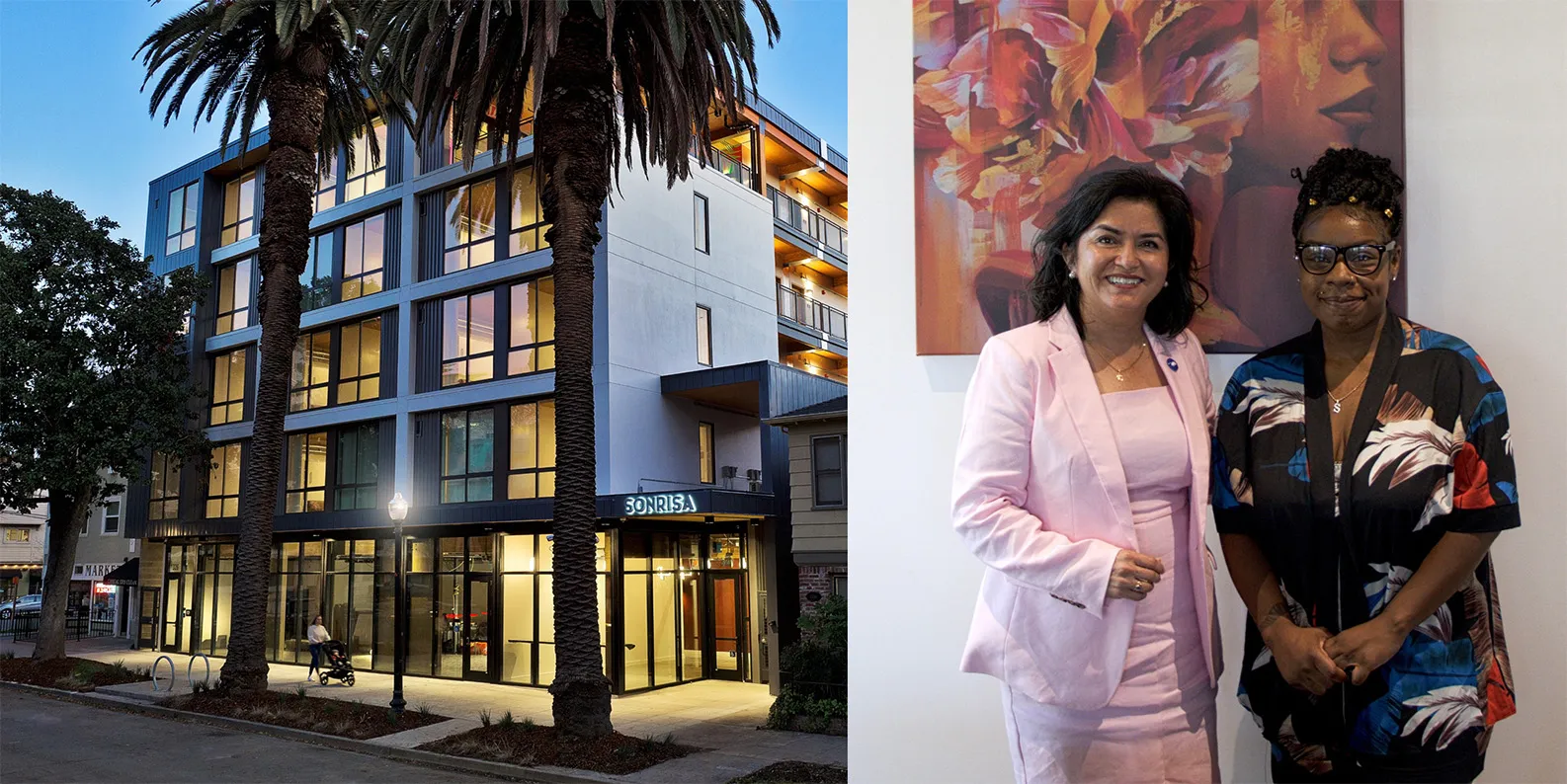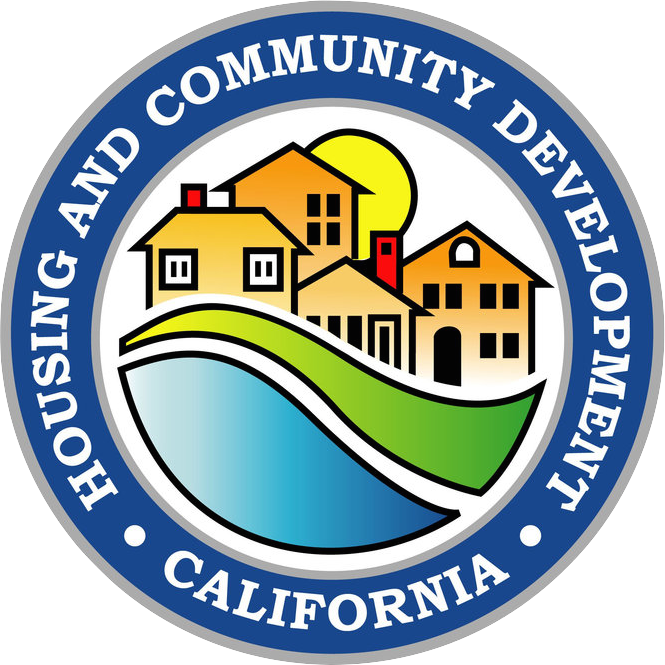Business, Consumer Services and Housing Agency and HCD Today Announced $21 Million to Advance Construction of Climate-Smart and Affordable Housing on State-Owned Lands
$21 million awarded in matching grants supports 369 new homes as part of the 5,500 new homes in the works on state-owned excess sites
July 13, 2023

Sonrisa Apartments. BCSH Secretary Lourdes M. Castro Ramírez with resident Samiya.
Sacramento, CA
Why it matters: Governor Gavin Newsom recognized the potential for underutilized state properties to play a key role in increasing housing availability in California. The effects of his executive order to explore this path are coming to fruition, with state property now housing low-income Californians and thousands more new homes in the works!
This year marked a milestone for Governor Gavin Newsom’s push to develop much-needed affordable housing on underutilized state land, as the first project awarded under an order to reimagine state excess sites for housing welcomed its first residents a year ahead of schedule.
In 2019, Governor Gavin Newsom signed Executive Order N-06-19 to address the state’s acute affordable housing crisis by identifying state lands for the potential development of affordable housing on underutilized infill sites. The order set a goal of expediting selected projects and requiring a collaborative government approach between the Department of General Services (DGS) and the Department of Housing and Community Development (HCD).
Since then, planning, funding, and construction of 5,500 new homes have been fast-tracked, and will create homes for tens of thousands of people over the lifetime of these communities. These homes will provide stability for working families and individuals and create jobs in communities around the state.
“California continues demonstrating the significant potential of repurposing public land for public good. We are unlocking state-owned lands and transforming them to housing—sustainable and affordable housing for hard-working Californians, older adults, and youth,” said Secretary Lourdes Castro Ramírez at the Business, Consumer Services, and Housing Agency. “These new homes are being built to last and in walkable, transit-adjacent and job rich neighborhoods to further our climate goals and improve the quality of life in communities.”
Part of the implementation of the Executive Order includes the Excess Sites Local Government Matching Grants Program (LGMG), an innovative and collaborative funding model administered by the HCD where the state, local governments, and selected developers work in partnership to build affordable housing on underutilized state-owned property. To date, the LGMG Program has provided nearly $60 million in grants to match more than $46.1 million that local governments are putting forward, filling gaps that slow down development of projects that align with state housing, climate, transit, and equity goals.
“The progress on Governor Newsom’s executive order showcases California’s commitment to addressing a critical housing shortage,” said Government Operations Agency Secretary Amy Tong. “We firmly believe this will have a profound impact on residents and businesses in downtown Sacramento.”
Today’s LGMG awards include:
- Mutual Housing in Sacramento received $10,000,000 for the development of a 242-unit affordable housing project in Sacramento. This project brought in more than $12,000,000 in local funding and will provide housing affordable to households making between 30% of Area Median Income (AMI) and 70% AMI.
- Visionary Homebuilders of California, Inc., also has received a Round 2 LGMG grant of $6 million to jumpstart construction of a 94-unit affordable development in Stockton.
- Related Companies of California, LLC, received $5 million to begin construction of the third phase of Sugar Pine Village in South Lake Tahoe, bringing local affordable and environmentally sustainable housing opportunities to help the workforce avoid long commutes.
"Since the inception of this housing program, DGS has been relentless in not only transforming state properties into affordable housing, but also in improving how we do so,” said DGS Director Ana M. Lasso. “We are particularly pleased to welcome creative partnerships with developers and to see those efforts bear fruit in such a diverse array of dwellings that will provide much needed housing to Californians."
“The Governor’s Executive Order to identify and make use of state-owned, excess infill sites has allowed us to focus efforts on building affordable housing in places accessible to jobs and transit, creating a win-win-win for residents, the environment, and communities,” said HCD Director Gustavo Velasquez. “HCD's Excess Sites Local Government Matching Grant Program has allowed us to foster a proactive partnership with local jurisdictions to expedite housing development on state land, filling funding gaps that can delay or derail development and leveraging local investments for maximum community benefit.”
Excess Sites Administered Jointly by HCD and DGS Brings Innovative Thinking and Local Investments to Build More Housing Faster
Here are some highlights of what the Excess Sites executive order has done so far:
- At 248 homes, Sugar Pine Village is the largest affordable multifamily development in the history of South Lake Tahoe. It exceeds the city’s planning goal for low-income homes and is being built with innovative modular construction that reduces construction waste and greenhouse gas emissions. The developer is partnering with the city and transit providers to increase bus connections throughout the region. This project took advantage of streamlining provisions in Senate Bill (SB) 35 and was fully permitted in just six months. The all-electric community with public service buildings powered by a microgrid is expected to serve as a resiliency center during inclement weather.
- Pacific Crest Commons in Truckee will also use modular construction, as its abbreviated construction schedule is important in an area with severe and unpredictable weather. The City of Truckee was awarded an SB 2 planning grant to plan for mixed-use and pedestrian-oriented development in the high-resource neighborhood surrounding the 55-unit community.
- Oak Hill Apartments, which features 250 homes in unincorporated Marin County, is the largest affordable multifamily development in Marin County in at least 50 years. The project is close to the SMART rail service that connects across the Bay Area, as well as bicycle and pedestrian trails, helping residents decrease their housing and transportation costs.
- Built in the 1950s, the decommissioned Montebello Armory adjacent to Montebello City Park will be adaptively reused and expanded with factory-built homes, creating 57 studio to three-bedroom homes for people exiting homelessness and low-income families. The property will feature beautiful common areas including a central courtyard and landscaped rooftop deck, as well as office space for supportive services.
- In San Francisco, the review and approval of plans for 262 homes for low-income residents were completed in under a year, significantly faster than the average housing project in the City and County is approved outside of the Excess Sites program. These homes will offer much needed affordability in an amenity and transit rich location.
- More than 1,000 mixed-income homes are in the works for state Excess Sites in the City of San Diego. The developer intends to use non-traditional funding sources to shorten the project timeline and preserve critical funding from more traditional sources for other affordable housing projects across the state. These sites are in downtown, where homes will be close to jobs, services, and transportation options that will deliver climate and affordability benefits for generations to come.
- In anticipation of HCD and DGS awarding an Excess Site there, the City of Riverside used an SB 2 planning grant to rezone a former CalFIRE property to permit dense, climate-smart infill development. This allowed the developer to accelerate environmental review, design, and approval of Mulberry Gardens, expediting delivery of 209 homes for low-income seniors and families.
- The City of Sacramento authorized the transfer of land to HCD to expand a project already in development on a state site. The transfer will add an additional 20 homes for low-income families and a childcare center, for a total of 124 affordable homes across the surplus city property and an excess state armory. The city also gave $3,700,000 to the project, which is located on an infill site directly adjacent to a SacRT light rail station that will connect residents to jobs and services without the need for driving.
For more information or to reach out for technical assistance visit Public Lands for Affordable Housing Development.

